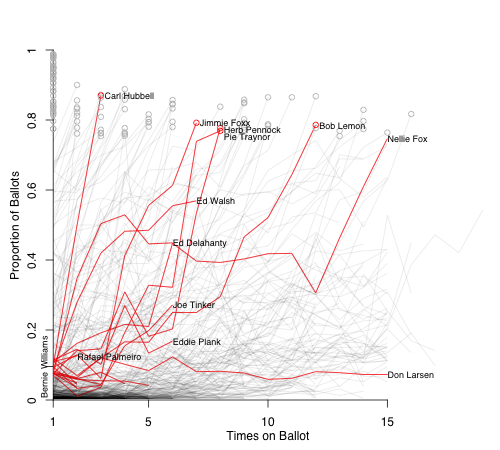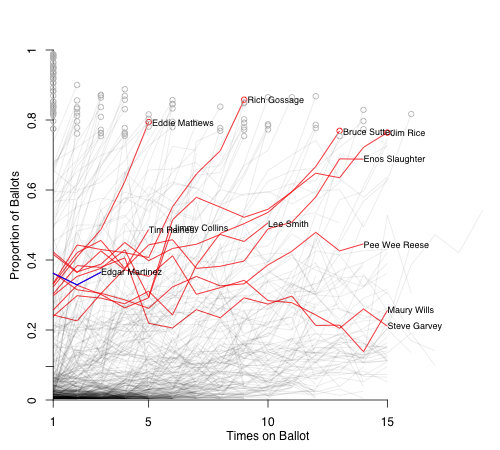
| F/X Visualizations | January 10, 2012 |
For the past two years I have written a post taking a graphical look at Hall of Fame vote histories for players with similar first-year vote totals to players on the current year's ballot. Here is 2010's, which includes a description of the graphs, and here is 2011's. As I said these graphs are not meant as sophisticated projection into the future, but rather just a rough look at historical precedent. Folks like Chris Jaffe of the Hardball Times have a better handle on the dynamics of HoF voting and future ballot composition in order to make better prediction.
This year's ballot had only one first-year player, Bernie Williams, who broke 5% and will be included on future ballots. Williams got 9.6% of the vote. Here I highlighted the vote trajectories of everyone else who got within 2.5% (7.1% to 12.1%) in their first year on the ballot.

There are a number of historical players who are not going to be a good guide for Williams' trajectory; Hall of Fame voting was much different in the past. Carl Hubbell, for example, was on 9.7% of the ballots in 1945, his first year; shot up to 50% in his second year; and by 1947 was inducted with 87%. Williams will not see a similar rise. More recent players in Williams's pool have fallen below the 5% cut off rather quickly. I left off the names because they would all bunch together but they include: Orel Hershiser, Graig Nettles, Bob Boone, Dave Stewart, Albert Belle, and Pete Rose. It will be interesting to see whether Williams can stick around for years like Don Larsen or fall off quickly like Hershiser and others.
With no other first-year guys above 5%, I am going to look at some guys who have been on the ballot for a couple of years. In each case I chose a salient feature of their vote history to create a comparison pool. Up first is Jack Morris, who, on his 13th year on the ballot, was on 66.7% of the ballots. This is a pretty big jump from last year's total of 53.5%. With no great first year players on the ballot, it seems voters were a little more liberal with their votes on returning players, many of whom saw a double digit rise. For Morris's comparison I looked at anyone else who received between 65% and 70% on some ballot after their 10th.

All these guys eventually made it. Three through the standard 75% BBWAA voting, and then Red Ruffing through a runoff ballot, and Enos Slaughter and Jim Bunning through the Veterans Committee. So things look promising for Morris.
Jeff Bagwell also had a nice increase, from 41.7% to 56%. Here are the players within 10% of these two vote totals.

This picks up other fast risers. Ryne Sandberg and Barry Larkin are bad comps because they are at the very high end of my comparison window for both years; Bagwell is not going to make it next year. He might slowly pick up steam like Andre Dawson or Tony Perez and make it around year ten. But with the amount of talent coming on and the PED stuff, I am not so sure.
I will skip Lee Smith and turn to Tim Raines. Raines has had a nice increase in vote share over the past three years, and is now at 48.7%. I looked at players within 10% of his year-3 to -5 ballots (because they are much higher than his first two years).

Except for Smith who is still on the ballot, all these guys are in the Hall. Johnny Evers and Bunning made it through the VC. As with the Bagwell example this might paint too sunny a picture for Raines.
Finally I look at Edgar Martinez. He did not get quite the same bump the other guys did, and has been pretty stagnant over his first three years. Here are players within 12.5% of each of his three vote totals.

Jack Moore at FanGraphs made the Pee Wee Reese comparison. I think that Jack is right that Martinez will probably end up with a Reese-, Maury Wills-, or Steve Garvey-like trajectory, and not one that takes him up rapidly like Eddie Mathews or Rich Gossage.